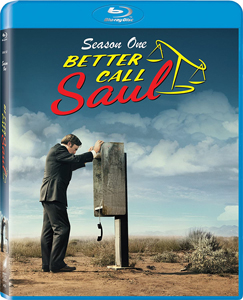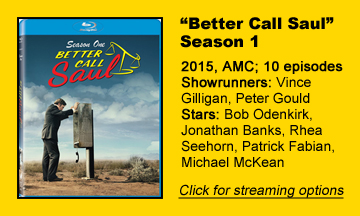With AMC’s “Breaking Bad” spinoff “Better Call Saul” set to air its sixth and final season later this year, we’re looking back at the first five seasons of Vince Gilligan’s second masterpiece series over five Thursdays. First up is Season 1 (2015):
An unassuming prequel
A couple years after “Breaking Bad” (2008-13) ended, Gilligan and co-creator Peter Gould somewhat quietly returned with the 10-episode first season of “Better Call Saul.”
It’s the prequel story of Saul Goodman (Bob Odenkirk) — real name Jimmy McGill — who enters the world of high-stakes, low-morals lawyering in much the same way Walter White (Bryan Cranston) gets into the meth business.
Again, Gilligan and his team don’t necessarily say it’s perfectly fine to skirt the law, but they do show how the same world that makes certain things illegal also pushes people into illegal activities.
I find it equally fun to watch Odenkirk as Cranston, and as a bonus, we get a good dose of Mike Ehrmantraut (Jonathan Banks).
The vast majority of viewers are watching “Better Call Saul” after “Breaking Bad,” but down the road this saga will be like the six “Star Wars” films, with different theories on the ideal viewing order.
Jimmy and Mike share spotlight
Imagining this is our first look at Jimmy and Mike, it plays equally well. We won’t know that Jimmy will eventually turn out to be Saul Goodman, very good at being a (good-hearted) bad guy, but we’ll be rooting for him to have success thanks to the likable performance by Odenkirk.
“Slippin’ Jimmy’s” small Chicago cons, tag-teamed with Marco (Mel Rodriguez), are entertaining, and they often play on people’s greed, so we don’t feel too horrible for the victims.
Mike’s backstory, meanwhile, starts in Philadelphia before he meets Jimmy while working a parking-booth job in the ABQ. Without much dialog, Banks projects an air of “What’s that guy’s story?” for a viewer watching the saga in chronological order.
Thankfully, Banks – long proven as a master of tough-guy roles – gets to expand his chops in the brilliant “Five-O” (episode 6), where Mike breaks down to his daughter-in-law while telling the truth about his son’s demise.
If Jimmy’s vintage moments are his scams, Mike’s remain the badass scenes, despite the rare glimpses of his softer side. We are treated to a gem in “Pimento” (9) when he disarms and disables a big-talking poser with two quick moves in a parking garage, maintaining his standard annoyed expression the whole time.
Mike’s credo is simple: He does the job he has agreed to do. But Jimmy’s journey toward the point where he abandons his pesky conscience and becomes “Saul Goodman” features wild swings. (Jimmy’s pseudonym isn’t mentioned this season, except when he uses it as an alias when a mark asks his name: “S’all good, man.”)
We like him so much, despite his “Slippin’ Jimmy” cons, because we regularly see him busting his butt to make it as an above-board lawyer. He works (and lives!) out of the back of an Asian nail salon and mimics the voice of a secretary who doesn’t exist. You can’t dislike someone who is so clearly on the bottom rung.

Slower than ‘Breaking Bad’ …
“Saul” Season 1 plays at a slower burn than “BrBa,” and it switches its focus a lot. It briefly becomes a law procedural; I got caught up in Jimmy’s mission to take down an elderly housing complex for its systematic overbilling of unwary seniors.
He digs through a Dumpster and painstakingly puts shredded documents back together, and we get a rare sense of a lawyer who is totally earning his billable hours. The case itself is never the main point, but Gilligan and company show they could do that show if they wanted to.
Along with the two “BrBa” carryovers, “Saul” hits us with great new characters. Jimmy’s girlfriend Kim (Rhea Seehorn) is the viewer’s mirror to Saul. She sees that Saul is perhaps a better person than the suits she works with at her large firm – and without a doubt he’s a more interesting person.
And there’s Jimmy’s older brother Chuck (Michael McKean from the “X-Files” two-parter “Dreamland,” written by Gilligan). McKean sinks his teeth into the role of a brilliant lawyer who has a condition (physical or psychological, we’re not sure) wherein electromagnetic rays hurt him. Chuck could fit in one of the sillier law shows except that “Saul” treats him seriously.
… but also funnier
For “BrBa” fans, “Saul” is a comfortable continuation in style and theme, but one welcome difference is that it’s funnier – even when it’s dark.
An early example of Saul’s nagging conscience comes in “Mijo” (2), when he talks drug dealer Tuco (Raymond Cruz, so good at playing terrifying yet dim) into merely breaking two hit-and-run scammers’ legs rather than killing them. Later comes Mike’s parking-garage moment.
In both cases, people scream and moan in pain off screen while Saul’s and Mike’s journeys continue in the frame. Because the victims are bad guys themselves, it falls on the right side of the line to be darkly funny. These low-level criminals – and higher-level ones like the elder-home fraudsters – exist in the world.
Saul and Mike are trying to make it in this same world. “Better Call Saul” has even less time for two-faced moralizing than “Breaking Bad” did, and it’s all the better for it.
IMDb Top 250 trivia
- “Better Call Saul” ranks No. 73 in the Top 250 with an 8.7 rating.
- That merely makes it the second-best series in this saga, according to voters, as “Breaking Bad” ranks No. 4 with a 9.4.
- Mike Ehrmantraut is popular with voters this season, as “Five-O” (6) and “Pimento” (9) lead the way at 9.5. Those episodes tell of Mike’s killings of his son’s murderers and his first steps into a bodyguard job, respectively.


